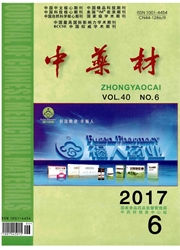

 中文摘要:
中文摘要:
目的:观察藏药二十味沉香丸对大鼠低氧性肺动脉压力升高干预作用,从而证实ET-1参与低氧性肺动脉高压的形成。方法:将165只Wistar大鼠随机分为高原对照组、二十味沉香丸藏药组和平原对照组,于给药后第1、3、7、15、30天用生理信号采集系统记录肺动脉压并计算左右心室质量比,用ELISA方法测定血清HIF-1α和ET-1蛋白水平,用Western Blot方法测定肺组织ETA受体水平。结果:与高原对照组比较,藏药二十味沉香丸组动物肺动脉压自给药后第7天显著降低(P〈0.01),自第3天左右心室比及血清HIF-1α含量显著降低(P〈0.05或P〈0.01),第3、7天血清ET-1含量显著降低(P〈0.05或P〈0.01),各时间点肺组织ETA受体表达均显著降低(P〈0.01或P〈0.001)。结论:ET-1是引起大鼠肺动脉压升高和右心室壁增厚的重要因素之一,其只在低氧早期发挥作用,并不参与低氧后期的肺动脉压升高。藏药二十味沉香丸能够防止大鼠肺动脉压过度升高和右心室壁增厚,其机制可能与直接抑制ET-1和ETA受体水平或抑制HIF-1α后间接引起ET-1水平下调有关。
 英文摘要:
英文摘要:
Objective: To investigate the role of Tibetan medicine-Twenty Wei Chenxiang Pill interfering with serum ET-1 level,in order to confirm that ET-1 is involved to the pathogenesis of hypoxic pulmonary hypertension. Methods: 165 Wistar rats were randomly divided into high altitude control group,Tibetan medicine-Twenty Wei Chenxiang Pill group and plain control group. The physiological signal acquisition system was used to record pulmonary arterial pressure,and RV /( LV + S) ratio were caculated. Serum HIF-1α and ET-1 protein levels were determined by the method of ELISA,and ETA protein levels in lung tissue were determined by Western Blot method. Results: Compared with the high altitude group,in the rats of Tibetan medicine-Twenty Wei Chenxiang Pill group,the pulmonary arterial pressure decreased significantly from the seventh day and the seventh day( P〈0. 01),the RV /( LV + S) ratio and serum HIF-1αlevels decreased significantly from the third day( P〈0. 05 or P〈0. 01),the serum ET-1 levels decreased significantly from the third day( P〈0. 05 or P〈0. 01),and the expression of ETA protein decreased significantly from the beginning( P〈0. 01 or P〈0. 001).Conclusion: ET-1 is one of the important factors causing pulmonary artery pressure increasing and right ventricular wall thickening,which plays a role in hypoxic pulmonary artery only involved in the early period hypoxia,but not in the later period. Tibetan medicinetwenty Wei Chenxiang Pill can prevent the pulmonary artery hypertension and the right ventricular wall thickening in rats,and its mechanism may be related to the direct inhibition of ET-1 and protein levels of ETA or the indirect downregulation of ET-1 level and ETA through inhibition of HIF-1α level.
 同期刊论文项目
同期刊论文项目
 同项目期刊论文
同项目期刊论文
 期刊信息
期刊信息
